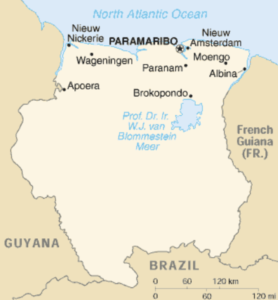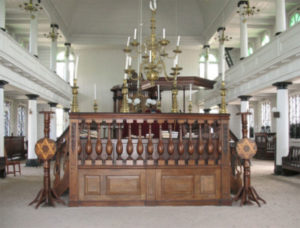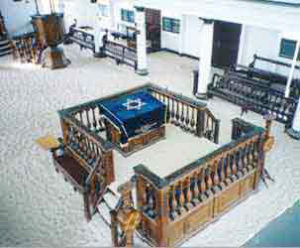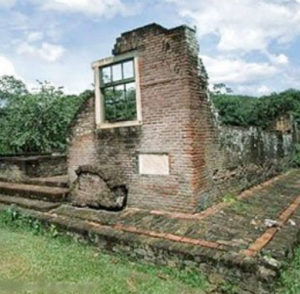 The first European explorer to set foot on the Surinamese shore was the legendary Spanish Conquistador Alonso de Ojeda, in 1499. Spain did not start to explore Suriname until 1593, but they didn’t settle there.
The first European explorer to set foot on the Surinamese shore was the legendary Spanish Conquistador Alonso de Ojeda, in 1499. Spain did not start to explore Suriname until 1593, but they didn’t settle there.
In 1629, the first group of Jews settled in the old capital of Suriname, Torarica (Portuguese for “rich or splendid Torah”). Jews of Portuguese descent, they came from Holland, arriving through Brazil, and started to lay out a number of sugar plantations on the west bank of the Suriname River.
A second group of Jews arrived and settled on the savannah. This area is nowadays known as the “Jodensavanne”. A third group of Jews arrived in 1664 and, together with the Jews of Torarica, moved and joined the Jodensavanne. The British colonial government granted several important privileges to the Jewish community, including freedom of religion and permission to build their own synagogues and schools. These privileges, which remained in place for more than 150 years. The first synagogue, Beracha Ve Shalom was built in 1685. The community continued to flourish and in the early 1700s, the Jews owned 115 of the 400 plantations in the country.
In 1712, pirates invaded Suriname. They demanded an enormous levy. The Jews had to pay the greater part of it in sugar, hard cash, and sugar mills. The country never recovered completely from this event. In addition, with the decrease in value of sugar cane by the introduction of beet sugar in Europe; the refusal of the banks to finance the Jewish settlers in rebuilding some of their plantations that were burned; led many inhabitants to settle in the new capital, Paramaribo.
 The Ashkenazi Neve Shalom Synagogue in Paramaribo, an elegant white wooden structure was first constructed in 1719. after the Ashkenazi synagogue was destroyed by fire, the community rebuilt it in 1835. A unique characteristic of the Neve Shalom Synagogue is its sandy floor. It is still in operation today. The Sephardi Zedek v’Shalom Synagogue, built in Paramaribo in 1735, has an interior reconstructed in Jerusalem’s Israel Museum. 1825, the Dutch canceled the special privileges that Suriname’s Jews had held since 1665.
The Ashkenazi Neve Shalom Synagogue in Paramaribo, an elegant white wooden structure was first constructed in 1719. after the Ashkenazi synagogue was destroyed by fire, the community rebuilt it in 1835. A unique characteristic of the Neve Shalom Synagogue is its sandy floor. It is still in operation today. The Sephardi Zedek v’Shalom Synagogue, built in Paramaribo in 1735, has an interior reconstructed in Jerusalem’s Israel Museum. 1825, the Dutch canceled the special privileges that Suriname’s Jews had held since 1665.
 The Jewish population declined during the first quarter of the 20th century. During World War II, a few Jewish refugees from the Netherlands and other parts of Europe settled temporarily in Suriname. By 1970, there were only about 500 people left in the community, which held alternating services at the synagogues of Congregations Neve Shalom and Zedek ve-Shalom, the congregations of the Ashkenazi and Sephardi communities respectively. When Suriname was granted independence in 1975, almost 35 percent of Suriname’s population left the country, fearing a collapse of the new country’s economy.
The Jewish population declined during the first quarter of the 20th century. During World War II, a few Jewish refugees from the Netherlands and other parts of Europe settled temporarily in Suriname. By 1970, there were only about 500 people left in the community, which held alternating services at the synagogues of Congregations Neve Shalom and Zedek ve-Shalom, the congregations of the Ashkenazi and Sephardi communities respectively. When Suriname was granted independence in 1975, almost 35 percent of Suriname’s population left the country, fearing a collapse of the new country’s economy.
In 1980, an Idi Amin-type army sergeant, Desi Bouterse, seized power with 15 other military men in a coup. He was responsible for a notorious massacre known as the December Murders and civil war raged for a decade. Most Jews had left the country by this time.
 In the 1990s the jungle in the Jodensavanne was cleared. About 450 Jewish graves were uncovered in the Cassipora Cemetery and the ruins of the earliest synagogue were preserved. The gravestones date from 1666 to 1873. Inscriptions are in Hebrew, Portuguese, Spanish, Aramaic and Dutch.
In the 1990s the jungle in the Jodensavanne was cleared. About 450 Jewish graves were uncovered in the Cassipora Cemetery and the ruins of the earliest synagogue were preserved. The gravestones date from 1666 to 1873. Inscriptions are in Hebrew, Portuguese, Spanish, Aramaic and Dutch.
Today the Jewish community has about 130 members. The two congregations, Sephardic and Ashkenazic, merged into one synagogue at Neve Shalom, which is larger and has a community hall and mikve. There is no longer a rabbi; the cantor directs the services. The second synagogue is rented to one of the members of the community and operates as a computer service shop. All the furniture and art of the old Sephardic synagogue was loaned to the Israel Museum in Jerusalem.